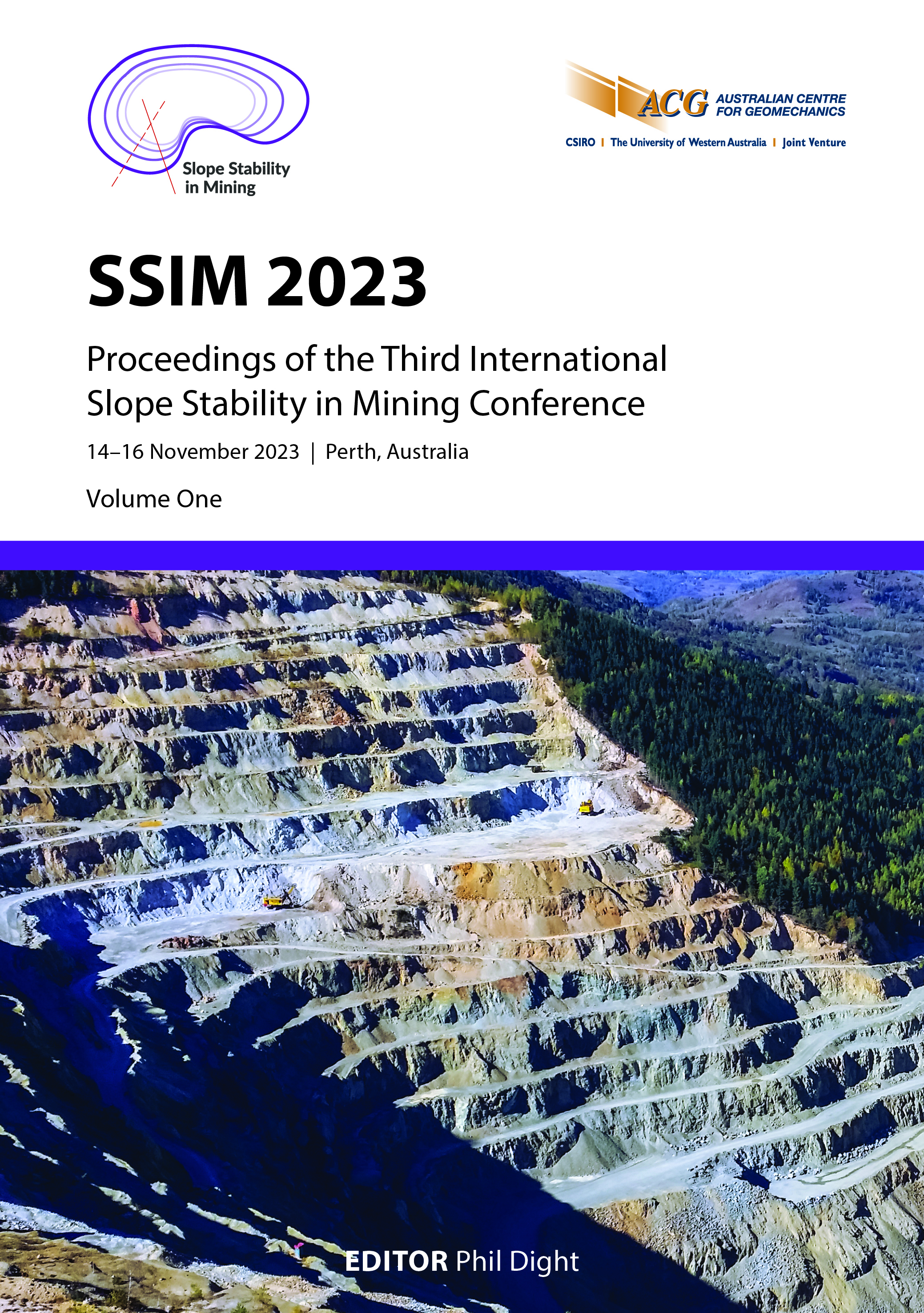Framework to predict open pit mine failure runout

|
Authors: Goldstein, D; Pace, R; Jung, JD; Young, D; Le Roux, KA |
DOI https://doi.org/10.36487/ACG_repo/2335_41
Cite As:
Goldstein, D, Pace, R, Jung, JD, Young, D & Le Roux, KA 2023, 'Framework to predict open pit mine failure runout', in PM Dight (ed.), SSIM 2023: Third International Slope Stability in Mining Conference, Australian Centre for Geomechanics, Perth, pp. 629-638, https://doi.org/10.36487/ACG_repo/2335_41
Abstract:
This paper focuses on the development of a framework implemented by Rio Tinto Iron Ore to systematically document 185 instances of slope failures in open pit mining operations located in the Pilbara region of Western Australia. With mining activities extending to deeper levels within intricate geological formations, often below the water table, the frequency and potential lethality of slope failures have escalated. While prevailing guidelines and industry standards recognise a Probability of Failure (PoF) of up to 30% for controlled benches in open pits, with no personnel at risk, the immediate attention following a fall of ground (FoG) is typically directed towards operational risk management and rehabilitation. Regrettably, the essential information pertaining to a FoG is frequently collected after the slope failure has undergone rehabilitation and operations have resumed, resulting in a delay in comprehending the underlying instability. This paper aims to rectify this issue by furnishing engineering personnel with a consistent and exhaustive dataset comprising FoG incidents. This dataset encompasses meticulous and comprehensive details including the circumstances surrounding each slope failure. The paper introduces novel empirical relationships enabling the estimation of the runout distance for slope failures in open pit iron ore mining. These relationships consider several factors including slope height and angle, rock mass conditions, geological setting, the failure mechanism and the volume of failed material. By integrating this information into geotechnical design and risk management, engineers can formulate runout predictions through failure back-analysis and calibration of PoF and material strength assumptions. The proposed data-driven approach aims to support geotechnical engineers and engineering geologists during both the design review and operational phases of mining projects. By adopting this framework, engineers can access a comprehensive dataset of FoG incidents, thereby facilitating calibrated geotechnical design and risk management practices. Ultimately, this strategy will enhance the safety and productivity of open pit mining operations.
Keywords: slope stability, slope failure, runout distance, fall of ground, reporting, geotechnical data
References:
Bar, N & Barton, N 2018, ‘Rock slope design using Q-slope and geophysical survey data’, Periodica Polytechnica,
Bar, N, Kostadinovski, M, Tucker, M, Byng, G, Rachmatullah, R, Maldonado, A, ... Yacoub, T 2020, ‘Rapid and robust slope failure appraisal using aerial photogrammetry and 3D slope stability models’, International Journal of Mining Science and Technology, vol. 30, no. 5, pp. 651–658,
Bar, N & McQuillan, A 2021, ‘Q-slope and SSAM applied to excavated coal mine slopes’, MethodsX, vol. 8,
Bar, N, Mojica, B, Cobián, JC, Bautista, M, Hammah, R, McQuillan, A, ... Preston, C 2022, ‘Cumba slope failure: a technical review’, Proceedings of Slope Stability 2022.
Corominas, J 1996, ‘The angle of reach as a mobility index for small and large landslides’, Canadian Geotechnical Journal, vol. 33, pp. 260–271.
Finlay, PJ, Mostyn, GR & Fell, R 1999, ‘Landslide risk assessment: prediction of travel distance’, Canadian Geotechnical Journal, vol. 36, pp. 556–562.
Hungr, O 1995, ‘A model for the runout analysis of rapid flow slides, debris flows, and avalanches’, Canadian Geotechnical Journal, vol. 32, pp. 610–623.
McDougall, S, McKinno, M, Hungr, O, Stead, D & Clague, J 2012, ‘Developments in landslide runout prediction’, Landslides,
pp. 187–195.
McQuillan, A & Bar, N 2020, ‘Open pit slope failure runout prediction’, Proceedings of Eurock 2020, International Society for Rock Mechanics and Rock Engineering, Lisbon.
Mitchell, A, McDougall, S, Whittall, J, Brideau, MA & McClarty, D 2018, ‘New empirical-statistical tools for the analysis of rock avalanche runout’, Proceedings of the 7th Canadian Geohazards Conference, pp. 3–6.
Read, J & Stacey, P 2009, Open Pit Slope Failure Runout Prediction, CSIRO Publishing, Melbourne.
Whittall, J 2019, ‘Runout estimates and risk-informed decision making for bench scale open pit slope failures’, Canadian Geotechnical Journal, vol. 57, no. 7, pp. 1044–1057,
Whittall, J, Eberhardt, E & McDougall, S 2017a, ‘Runout analysis and mobility observations for large open pit slope failures’, Canadian Geotechnical Journal, vol. 54, no. 3, pp. 373–391,
Whittall, J, McDougall, S & Eberhardt, E 2017b, ‘A risk-based methodology for establishing landslide exclusion zones in operating open pit mines’, International Journal of Rock Mechanics and Mining Sciences, vol. 100, pp. 100–107,
Whittall, J, Mitchell, A & McDougall, S 2020, ‘Runout of open pit slope failures: an update’, in PM Dight (ed.), Slope Stability 2020: Proceedings of the 2020 International Symposium on Slope Stability in Open Pit Mining and Civil Engineering, Australian Centre for Geomechanics, Perth, pp. 1149–1162,
Zou, Z, Xiong, C, Tang, H, Criss, RE, Su, A & Liu, X 2017, ‘Prediction of landslide runout based on influencing factor analysis’, Environmental Earth Sciences, vol. 76, no. 21,
© Copyright 2025, Australian Centre for Geomechanics (ACG), The University of Western Australia. All rights reserved.
View copyright/legal information
Please direct any queries or error reports to repository-acg@uwa.edu.au
View copyright/legal information
Please direct any queries or error reports to repository-acg@uwa.edu.au

